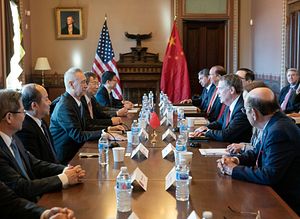The world is anxiously watching to see if the United States and China will conclude a “phase one” deal and put a brake on the ongoing trade war before December 15, when additional tariffs are set to kick in. U.S. President Donald Trump stoked the fire with a tweet on Thursday that the U.S. is “Getting VERY close to a BIG DEAL with China.” Still, expectations for the deal, even if concluded, are low, because it focuses on tariff reduction and farm goods purchase and leaves the contentious issues like China’s industrial policies and domestic subsidies for later deals.
Unfortunately, there is another reason to be pessimistic. The expected deal — or any later deals, for that matter — will not solve a key underlying reason behind the protracted trade war: a problem of commitment. Neither side can trust the other to honor an agreement.
To explain, it is instructive to draw on international relations scholarship. Particularly, political scientists identify three major factors behind interstate disputes. These factors help explain how the trade war started and why it has dragged on.
The first factor is imperfect information. If states know beforehand how much capability and resolve each side has, they can in theory judge who will win and who will back down; armed with that information, they can reach a settlement. But in reality, they do not have such information. They may miscalculate that the other side lacks the capability and/or resolve to fight, and escalate, thinking that the other side will surrender. Moreover, states often bluff. States may wrongly call the other’s bluff and escalate, only to find themselves embroiled in war in the end.
The U.S.-China trade war started with this dynamic. When Trump launched the war by putting tariffs on Chinese goods, he overestimated America’s economic leverage and underestimated Beijing’s resolve. Despite his claim that the trade war would be “easy to win” since America’s economy is stronger than China’s, President Xi Jinping turned out to be willing to stomach the pain and retaliate.
At the same time, Chinese leaders miscalculated that Trump was bluffing with his tariff threats and would be pressured to back down if his supporters were hit hard by retaliatory tariffs. Instead, farmers, who are hit the most by those tariffs, still overwhelmingly support Trump. His approval rating among Republicans has never dipped below 79 percent. Enjoying such support, Trump has doubled down on his tariff measures. And the Chinese retaliated yet again.
The second factor driving interstate disputes is what scholars call issue indivisibility, a situation in which the issues at stake are indivisible, or non-negotiable. Understandably, if one state makes demands that are unacceptable to the other, the negotiation goes nowhere.
Trump issued unrealistic demands against Beijing. He claimed that China must end its unfair practices such as domestic subsidies and industrial policies like “Made in China 2025.” While his other demands, such as intellectual property protection and market access, are easier to meet — China has recently made progress in these areas — scrapping subsidies and industrial policies are not. The latter are core to Beijing’s developmental model and the Communist Party’s rule. So long as the Trump administration pushes these nonstarters, a deal remains unlikely.
The good news is that these two issues are manageable. Imperfect information disappears as states negotiate and learn about each other. By now both Trump and Xi should have figured out that they cannot simply force their way to a victory in the trade war. Issue indivisibility is also surmountable, because states could over time identify where potential common ground lies. The United States and China seem to have understood this, focusing only on easier items like tariff reduction and farm goods purchase in a phase one deal and putting aside harder items like structural issues for later deals.
The bad news is that the third factor – commitment – is more difficult to overcome. Even when an agreement is reached, there is no guarantee that each side will honor it. There is no higher authority that enforces intergovernmental agreements. (There is the WTO dispute settlement mechanism, but it is now dysfunctional due to the Trump administration’s refusal to nominate its judges.)
The commitment problem has already impeded the U.S.-China negotiation. On the one hand, the United States cannot trust China to make progress on structural reforms, since Beijing has not kept its promises to liberalize its economy, and instead committed intellectual property theft, since joining the WTO in 2001. Washington has sought to create an enforcement mechanism in a trade deal to ensure Chinese compliance, but to no avail.
China, on the other hand, cannot put faith in the U.S. president, who frequently changes his mind and makes policy reversals. It would damage Xi politically if Trump were to wake up one morning and announce new tariffs in a tweet after a deal is signed. A successful agreement requires a mutual commitment.
A “phase one” deal will not solve this. What’s more, things will get tougher as the negotiations for later deals address structural problems that require still greater commitments. So the trade uncertainty will continue, even after an initial deal.
Daisuke Minami is an expert on East Asia and U.S. foreign policy and has a Ph.D. in political science from The George Washington University.

































